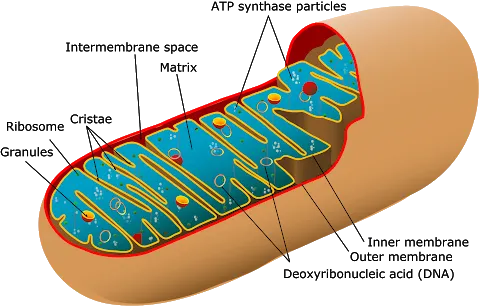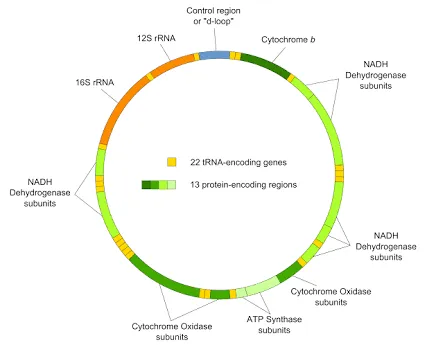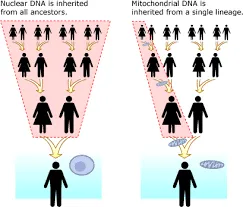Hello steemians!!!
The DNA is something we've all heard about at one time, but the type we're more familiar with is the nuclear DNA(the one that is unique to one individual), I discussed the nuclear DNA in a previous post Here
In this article though, we're looking at a different type of DNA; the Mitochondrial DNA (mtDNA), as the name implies, it is found in the mitochondrion and quite different from the nuclear DNA. The aim of this post is to make you understand all about the mtDNA, its functions and the difference between the mtDNA and the nuclear DNA.
Before we look at the mtDNA, let's back track a little and talk about the mitochondrion; from basic biology, the mitochondrion is simply an organelle found in the cytoplasm of eukaryotic cells and also called the "power house" of the cell.
The main function of the mitochondrion is to produce ATP(Adenosine triphosphate) through oxidative phosphorylation. It also has a role in other metabolic activities such as;
Mitochondrial reactive oxygen species signaling
Apoptosis (programmed cell death)
Calcium signaling
Cellular metabolism regulation.
The structure of the mitochondrion is such that it has five distinct parts;
Outer Membrane: this part encloses the entire organelle
Intermembrane space: this is the space between the outer membrane and the inner membrane
Inner membrane: this is where most of the protein in the mitochondrion can be found
Cristae: they are fold-like structures that can be found within the inner membrane and they expand the surface area of the inner membrane.
Matrix: this is the inner space enclosed by the inner membrane. The matrix functions in the production of ATP with the help of ATP synthase found in the inner membrane.
Now that we have a brief understanding about the mitochondrion let's now get to the reason why you're probably reading this post; the Mitochondrial DNA.
Mitochondrial DNA
While most of the DNA can be found in the nucleus, the mitochondrion also also has it's own genetic material; the mtDNA. The human mtDNA contains only 37 genes; 13 are for proteins, 22 for transfer RNA (tRNA) and 2 for ribosomal RNA (rRNA). In the human mtDNA 100-10,000 copies are present per cell. Unlike the nuclear DNA, the mtDNA has fewer repair mechanisms which causes it to have a higher mutation rate.
Origin of the Mitochondrial DNA.
It is believed that the mtDNA was derived from the genomes of prokaryotes (bacteria) that were engulfed by the ancestors of the eukaryotic cells. This theory is known as the endosymbiotic theory.
Structure of the Mitochondrial DNA
Unlike the nuclear DNA that is linear, the mtDNA is circular and also double stranded. The two strands are differentiated by the amount of nucleotide they contain, one strand is rich in guanine and is referred to as the "heavy strand", the other strand is rich in cytosine and is referred to as the "light strand".
The total number of genes found in the human mtDNA is 37, with 22 genes for tRNA, 13 for proteins and 2 for rRNA. In each cell, about 100-10,000 copies of mtDNA can be found and each mtDNA contain about 15,000 to 17,000 base pairs.
Inheritance of the Mitochondrial DNA
Mostly in multicellular organisms the mtDNA is inherited maternally i.e from the mother. This can also be referred to as Uniparental Inheritance. In sexual reproduction, the mitochondrion present in the sperm are usually destroyed by the egg cell during fertilization.
Due to the fact that mitochondrion is usually present at the tail of the sperm, it is easily lost during fertilization.
Because of the maternal inheritance of mtDNA, it can be used to trace maternal lineage from way back and this is due to the fact that mtDNA is stable and unchanging in all generations.
Uses of mtDNA in Identification
The mtDNA is mostly used in identification to establish relationships between individuals of the same maternal lineage and this is based on the fact that it remains the same in all generations.
It can also be used in the study of genetic relationships of individuals within the same species and to also identity evolutionary relationships between individuals of different species. This is done by extraction of the mtDNA and also comparing between the mtDNA to note for similarities and differences. The data gotten from this could be used in creating a network of relationship between the individuals.
It is also used in forensics to solve cases where the biological sample is old and degraded. This is because degraded samples will most likely lack nuclear DNA because it is easily degraded but mtDNA remains stable over time. It could also be used in identifying victims of mass disasters, solving cases of missing persons.
The reasons why mtDNA is stable over time and present even in degraded samples is because of it's structure and the location inside the cell.
Differences between Nuclear DNA and mtDNA
Location: The nuclear DNA is located in the cell's nucleus while the mtDNA is located in the mitochondrion.
Structure: They are both double stranded but the Nuclear DNA is linear while the mtDNA is circular
Size: In humans, the mtDNA has only one chromosome with 16,569 base pairs while the nuclear DNA has 46 chromosomes with 3.3 million nucleotides.
Inheritance: The nuclear DNA diploid, that is, it is inherited both paternally and maternally, 23 chromosomes from the mother and 23 from the father. The mtDNA is haploid since it is inherited maternally and doesn't undergo genetic recombination.
The Advantages and Disadvantage of the mtDNA
It is more stable over time even in degraded biological samples. Due to it's multiple number per cell(about 2-10 per cell), mtDNA isolation is easier. It can be found in samples such as hair, bone, teeth and this helps in studying these samples.
The one disadvantage of mtDNA analysis is it cannot distinguish between individuals of the same maternal lineage, for example, between brothers the mtDNA profile will be the same.
I'll conclude with this; while the nuclear DNA is a more powerful tool in that it is unique for individuals, the mtDNA has a lot of possibilities and uses that the nuclear DNA can't even beat.
Thanks for reading through✌
Sources


